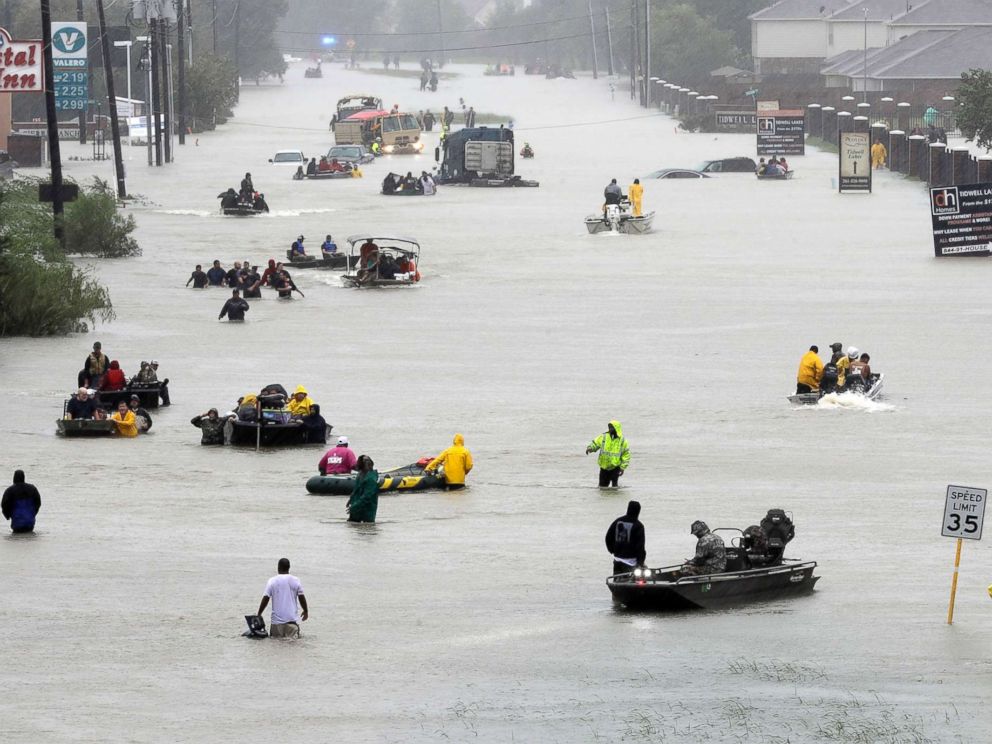Risk modelling firm AIR Worldwide has provided an estimate of the total property damage from hurricane Harvey’s flooding at between $65 billion and $75 billion, while the risk modeller also estimates private insured wind, surge and flood losses of over $10 billion.

Hurricane Harvey flooding in Houston - Photo from ABC News
The flooding property loss of up to $75 billion includes damage to properties eligible for coverage, whether they are actually insured or not and without any application of deductibles or limits, but do not include losses from Harvey’s winds or storm surge.
AIR puts insurance and reinsurance industry losses from hurricane Harvey’s wind, flood, and storm surge combined at over $10 billion, around $3 billion of which is due to winds and storm surge. These estimates do not include losses that fall to the National Flood Insurance Program (NFIP).
AIR explains hurricane Harvey:
After making landfall as a Category 4 hurricane near Rockport, Texas, on Thursday, August 24, hovering over Texas for the next 5 days, and then travelling through western Louisiana the following week, Harvey was downgraded to a remnant low over the weekend of September 2–3; it then moved into the Ohio Valley and dissipated. According to AIR, it had been almost a decade since the last hurricane landfall in Texas—Hurricane Ike in 2008—and the last Category 4 storm to impact the state was Hurricane Carla in 1961. The last Category 4 hurricane to make landfall anywhere in the U.S. was Charley in 2004, which struck southwestern Florida.
Harvey brought excessive and record-breaking rainfall; 51.88 inches were recorded in Cedar Bayou near Houston, which shattered the previous 48-inch rainfall record from any tropical storm or hurricane in the contiguous United States set by Tropical Storm Amelia in 1978 in Medina, Texas. The National Weather Service in Houston officially recorded 43.38 inches and 32.47 inches were recorded at Houston Hobby Airport, which exceeded the previous 3-day record for any major U.S. city. In Beaumont, 26.03 inches of rain were recorded on Tuesday, August 29, more than doubling its prior daily rainfall record of 12.76 inches set in 1923; the rainfall total there has been reported at 47.35 inches. As of Wednesday, more than five stations across southeastern Texas had surpassed 45 inches of rainfall. Reports indicate that Harvey dropped a total of 27 trillion gallons of rain on Texas and Louisiana in 6 days.
According to AIR, more than half of the 120 river gauging stations in the Houston/Galveston area were in various stages of flooding during the event; several experienced major flood stages and crested with new record-setting flood levels. Buffalo Bayou, which flows through downtown Houston, crested at 63.5 feet—2 feet higher than the previous historical record of 61.2 feet set in 1992. Cypress Creek, which flows through neighborhoods north of downtown Houston, crested about 3 feet higher than the previous record of 94.3 feet set in 1949. Similarly, Neches River at Beaumont crested at 21.5 feet, about 10 feet higher than the previous record set in 2006. Flood levels corresponded to astounding 750-, 200-, and 100-year return periods for river water level stages on Cypress Creek near Westfield, Greens Bayou near Houston, and on West Fork San Jacinto River near Porter, Texas.
Homes in and around Houston are under 3 or 4 feet of water, overtaken by river and bayou flooding, with some residents reporting waterlines at more than 6 feet in their flood-damaged properties. In Wharton, the overflow from Houston has traveled southward and flooded homes. Much of the affected area is still flooded, although waters have receded in some areas.
AIR’s property loss estimates for flooding from Harvey capture losses from inland flood both on and off the floodplain based on simulated event scenarios that reflect uncertainty in precipitation observations, river flows, and modeled levee failures. The modeled hazard intensities reflect the maximum estimated river flows and maximum excess runoff intensities during the event from August 25–31, 2017.
AIR includes the following in its estimates; onshore residential, commercial, and industrial properties and their contents, automobiles, and time element coverage (additional living expenses for residential properties and business interruption for commercial properties); but not contingent business interruption losses resulting from the closure of oil refineries in the region.

